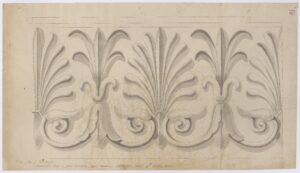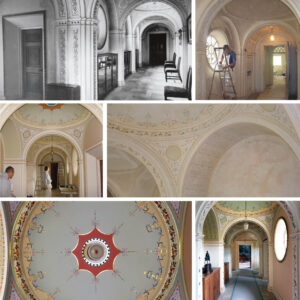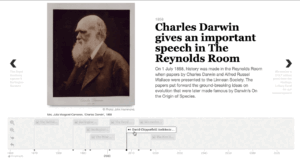Denaturalized History Display:
How do art spaces mediate the history of itself to the audience?
Exploring identity in the gallery space invites a thoughtful examination of the historical events that contributed to its character. Considering a building as an ‘architectural text’ allows one to recognise the complexity of the task.[1] Thus, in contemplating the role of contemporary art spaces within the context of their historical legacies, it is interesting to consider how these institutions serve as bridges between their storied past and their vibrant present. The transformative journey of various art spaces, for example: König Galerie once the St. Agnes Church, Fruitmarket Gallery, a bustling market adjacent to a train station, the Baltic Centre for Contemporary Art formerly a flour mill, and even skating rinks (La Patinoire Royale – Galerie Valérie Bach). These evolutions highlight the adaptive nature of these spaces, each bearing the imprints of its former identities.
The Talbot Rice Gallery (TRG) also has undergone several transformations over the years. From the dates of illustrations in Andrew Fraser’s book The Building of Old College: Adam, Playfair & the University of Edinburgh. From being known as Play-Fairs’ Upper Museum in 1816 to becoming the Natural History Museum of the University and later a Reading Room in 1949. Today, it is known as Talbot Rice Gallery, as it appeared in 1974.[2] The task presented to our group within the Guided Research Placement Brief probes the essence of these transformations: “How can a contemporary art gallery create productive and critical relationships to the history of its spaces which also engage audiences?” In the case of the TRG, a part of the essence of the building was faded into history, and can only be found via photographic reconstructions, stories and memories. The presence of the collections, for example, which were displayed in the display cases, can no longer be perceived.

College of Edinburgh, Ornament frieze of Great Entablature: Upper Museum, No.84 © the University of Edinburgh
To further discuss this question, we need to challenge the existing perspective of viewing the Talbot Rice Gallery’s history and present it in a way that informs the audience. Therefore, I divided the remaining trace of its history into two strata: the tangible, like the architectural integrity, and the intangible, such as the cultural imprint of its former roles. In examining the remnants that echo within the walls of the Talbot Rice Gallery, one’s gaze is naturally drawn to the neoclassical flourishes, like the honeysuckle flower frieze adorning the columns — a hallmark of William Playfair’s design dating back to 1818. This detail not only exemplifies the architectural heritage of the space but also serves as a bridge to its layered history. Similarly, Dumfries House stands as a paragon of Neoclassical architecture, where Robert Adam’s enduring legacy is preserved both in original form within the Pewter Corridor and through sympathetic restorations that breathe new life into the space. This harmonious blend of the old and the new provides a tangible, evolving story of space and purpose, a narrative thread that the Talbot Rice Gallery could weave into its fabric of identity.

The Pewter Corridor © Dumfries House
To deepen the engagement with this historical dialogue, we decided to curate a suite of interpretive programs that offer a rich exploration of the gallery’s historical layers. Envision a series of self-guided tours, perhaps using transparent paper to print the archival images from the Centre for Research Collections, allowing visitors to overlay the past onto the present. These resources, available through thoughtfully produced pamphlets, would not only highlight the architectural nuances of the gallery but also serve as a narrative map, guiding visitors through the various stories of the Old College. Through representations or physical displays of old photographs and plans, the narrative of the space unfolds, providing context and depth to the visitor’s experience. This approach promises a multi-sensory engagement with the space, where visitors are not merely observers but participants in a historical journey. Through these layers of interpretive storytelling, the exhibition experience becomes a tapestry of temporal threads, each visitor’s path stitching together the historical fabric of the building with the evolving tapestry of contemporary culture housed within its walls.
Site-specific historical art commissions, such as Michal Barr’s Creative Creatures in Old College, bring back the history of the Natural History Museum, a duration when the building collected different specimens, and serve to anchor the gallery’s presence in its historical roots. Which’s picture will be put in our exhibition to elaborate on the connection between history and residency practice. Such art pieces, akin to the installations by Anicka Yi in the Turbine Hall, can be conceived to directly interact with the historical and architectural essence of the space, thereby crafting a dialogue between the bygone and the current. For example, Yi’s “In Love With The World” at the Tate Modern’s Turbine Hall, where her ‘aerobes’ diffuse scents that chronicle the site’s history from the ancient past to the industrial age, is emblematic of how contemporary art can embody the temporal layers of a site, making the past tangible in the present through scent and movement. The intangible heritage of a gallery space, especially in its capacity to convene and engage, persists through the very atmosphere and ethos it fosters.

Our buildings-The architecture of the RA: Timeline © Royal Academy of Arts
Following the precedent-setting RA250 architectural project at the Royal Academy of Arts,2018 added 6 Burlington Gardens, once housing the Museum of Mankind, to the programme. Now transformed into an art space, a dynamic timeline on the Royal College of Art’s official website presents important events that have taken place in the space at different points in time. It also connects buildings from different periods and styles to form an integrated cultural campus that not only showcases contemporary architectural interventions, but also integrates historical narratives into the experience.[3] fusion of past and present is not only a curatorial decision but a strategic engagement with the gallery’s heritage.
[1] Raffaella Maddaluno, “FROM THE PLACE OF “PRODUCTION MACHINES” TO THE PLACE OF “DREAM MACHINES” The factory space as a praise for emptiness,” Icon 25, no. 1 (2020),https://www.jstor.org/stable/26983774.
[2] Andrew G. Fraser, The building of Old College : Adam, Playfair & the University of Edinburgh / Andrew G. Fraser (Edinburgh: Edinburgh University Press, 1989).
[3] “The architecture of the RA,” Our buildings, Royal Academy of Arts, accessed 23.2, 2024, https://www.royalacademy.org.uk/buildings.
(College of Edinburgh, Ornament frieze of Great Entablature: Upper Museum, No.84 © the University of Edinburgh)

Comments
This case study illustrated a strong link between Old College’s history and its structures. Starting from the Ornament Frieze of Great Entablature and The Pewter Corridor, these images have brought us back to the nineteenth century, then came to the main question: How do art spaces mediate the history of itself to the audience? The author depicted architectural integrity and the cultural imprint of its former roles to expand her topic. This case study is a structured blog of the forms of interaction between the historical traces left by the structure in the old college and the contemporary audience, I’d like to read more about it!